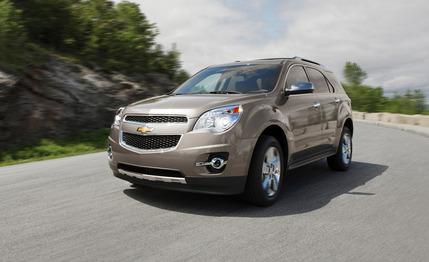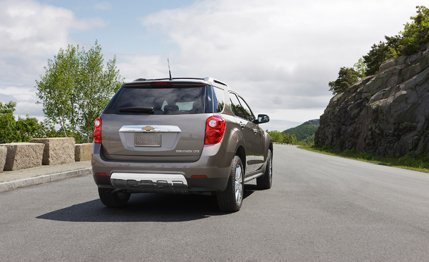 First Drive Review
First Drive Review
Within the past year, the Honda CR-V and the Ford Escape—two 800-pound gorillas in the compact-crossover segment—have been completely redesigned. (The Toyota RAV4, a multiple comparison-test winner, will get a reboot soon.) But with no full do-over on the docket just yet for its handsome but ho-hum Equinox, Chevy clearly still had to make a move. Honda has never offered a V-6 in the CR-V, the 2013 Escape went exclusively four-cylinder (albeit with two optional turboed engines), and Mazda’s CX-5 is packing the least powerful four-banger in the segment, despite being brand-new. For Chevy, then, getting rid of the 264-hp, 3.0-liter V-6 would make sense, right? Except it bucked the downsizing trend and replaced the 3.0-liter with a 301-hp, 3.6-liter direct-injected V-6. Wait, what?
This latest version of the 3.6 sees duty across the GM portfolio, the Cadillac CTS and the 2013 GMC Terrain among others. The good news for the fuel-conscious is that estimated economy figures for the new V-6 versus the 3.0 are identical—17 mpg city and 24 highway with front-wheel drive and 16/23 with AWD (okay, so good news for the sorta fuel-conscious)—despite the increases in displacement and power. We estimate 0-to-60-mph times of 6.8 seconds for the front-wheel-drive version and 7.2 seconds for all-wheel-drive models. (A four-cylinder model we tested did the deed in 8.7 seconds.)
We had a chance to drive all-wheel-drive Equinoxes with old and new V-6s back-to-back, and we found no difference in drivability beyond the extra kick in the pants. The upshift-happy six-speed automatic carries over, as do high output peaks that encourage a heavy right foot and make frugality difficult. (The previous V-6 offered maximum power and twist at 6950 and 5100 rpm, respectively; the new motor churns them up at 6500 and 4800.) From the sliding rear seat, however, we detected a significant difference in engine noise. The 3.6 is considerably louder for those in the second row, who are treated to a slightly buzzy, metallic note.

Along with the new engine comes a revised suspension. The Equinox now features dual-flow dampers; the 2013 Chevy Traverse, the 2013 Buick Enclave, and the Equinox’s equally updated 2013 GMC Terrain platform mate are among the other vehicles that get them. The result is less bobbing and weaving over undulating surfaces and an incrementally improved perception of grip during cornering.
As for the interior, Chevy MyLink with navigation makes its way to the options list for the first time—in the past, buyers were forced to choose between a navigation system and MyLink—although it will be available only on the mid-level LT and range-topping LTZ trim levels. Those two trims also gain an eight-way power passenger seat (optional on the LT) and a Safety package, which includes forward-collision alert, lane-departure warning, and radar-based rear park assist. Also new is an available rear-seat entertainment system that includes monitors in the back of the front headrests, dual wireless headphones, and a dual-player DVD setup—again, available as an option only on LT and LTZ trims. With any luck, it’ll distract the kids from the engine noise.
Considering the speed at which the segment turns over—and the excellence found within it—Chevy needed to tinker with the Equinox, an entry that has never been fully competitive. But slightly improved handling and more power only go so far, and they do nothing for the poor rear visibility, hefty curb weight, and overall lackluster dynamics that keep this Chevy behind much of its competition. We’d consider hitting the Ford, Mazda, or Honda stores instead.